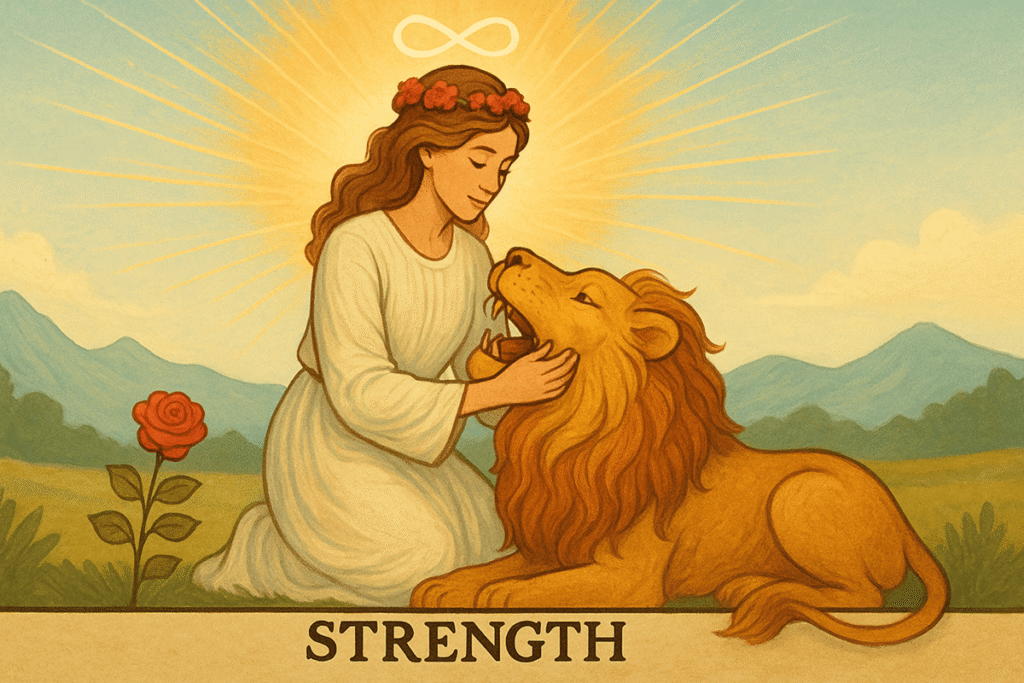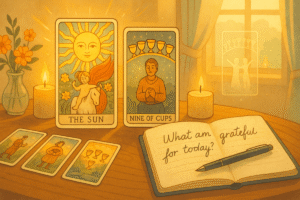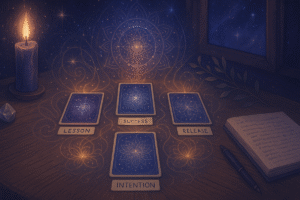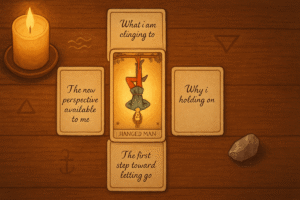Table of Contents
When I first encountered the Strength card in a tarot deck, I’ll admit I was expecting something quite different. Perhaps a warrior in armor, or someone flexing impressive muscles. Instead, I found myself looking at a gentle figure, often depicted as a woman, calmly closing or opening the jaws of a lion. The image puzzled me at first, but over time, it became one of my favorite cards to contemplate when thinking about what true resilience actually means.
The Gentle Power Within the Card’s Imagery
The traditional Strength card presents us with a fascinating paradox. Here we see what appears to be the most vulnerable person imaginable, typically a young woman in flowing robes, engaged with one of nature’s most formidable predators. Yet there’s no fear in her posture, no struggle or violence. Her hands rest gently on the lion’s jaw, and both figures seem oddly at peace with each other.
This imagery challenges our conventional understanding of strength. We’re conditioned to think of power as loud, forceful, and dominating. The card suggests something entirely different. Perhaps true strength lies not in overpowering opposition, but in understanding it. Maybe resilience isn’t about building walls, but about learning to dance with whatever challenges us.
The lion itself holds deep symbolic meaning across cultures. It represents our primal instincts, our fears, our anger, and yes, our raw power. But notice how the figure in the card isn’t trying to kill the lion or chain it up. She’s simply… there with it. Present. Patient. This presence itself becomes a form of influence far more profound than brute force could ever be.
What Inner Resilience Really Looks Like
I think we often misunderstand what resilience means in our daily lives. We picture someone who never breaks down, never shows vulnerability, never admits to struggling. The Strength card invites us to reconsider this definition entirely. What if resilience isn’t about being unbreakable? What if it’s about staying present with our own inner turmoil?
Consider the moments in your life when you’ve felt most challenged. Were you able to overcome those situations through force alone, or did something else carry you through? Perhaps it was your ability to remain curious about your experience, even when it felt overwhelming. Maybe it was your willingness to sit with discomfort rather than immediately trying to escape it.
The card seems to suggest that our greatest strength emerges when we stop fighting ourselves and start befriending the very parts of us that feel most threatening. This doesn’t mean becoming passive or accepting harmful situations. Instead, it means approaching our internal struggles with the same gentle confidence displayed by the figure in the card.
The Art of Gentle Influence
There’s something almost magical about gentle influence, though it’s easy to overlook in our action-oriented culture. Think about the people in your life who have had the most profound impact on you. Were they the ones who tried to force you to change, or were they the ones who simply showed up consistently with patience and understanding?
The Strength card embodies this principle of gentle influence. The woman’s power doesn’t come from her ability to dominate the lion, but from her capacity to remain centered in its presence. This creates space for a different kind of relationship to emerge, one based on mutual respect rather than conquest.
In our own lives, we encounter “lions” regularly. These might be difficult emotions, challenging relationships, overwhelming circumstances, or aspects of ourselves we’d rather not acknowledge. The card invites us to consider how we might engage with these challenges differently. What would it look like to approach your anxiety with curiosity rather than resistance? How might your relationship with failure change if you treated it as a teacher rather than an enemy?
When Compassion Becomes Your Superpower
Perhaps one of the most revolutionary aspects of the Strength card is how it positions compassion as a form of power. In many contexts, compassion is viewed as weakness, something that leaves us vulnerable to being taken advantage of. The card suggests the opposite might be true.
Compassion, particularly self-compassion, requires tremendous courage. It means staying present with pain rather than numbing it. It means acknowledging our mistakes without drowning in shame. It means extending understanding to parts of ourselves we’d rather hide from the world.
I’ve noticed that when people are genuinely compassionate with themselves, they paradoxically become more resilient, not less. They bounce back from setbacks more quickly because they don’t waste energy in self-attack. They’re more willing to take risks because they know they’ll treat themselves kindly if things don’t go as planned. They build stronger relationships because their self-acceptance allows them to be more authentic with others.
The Lion Within Each of Us
Every person carries within them what we might call their “inner lion.” These are the parts of ourselves that feel wild, unpredictable, or potentially destructive. For some, this might manifest as anger or aggression. For others, it could be intense creativity, passionate desire, or fierce independence. These aspects of ourselves often feel scary because they’re powerful and not always under our conscious control.
The Strength card doesn’t suggest we should eliminate these qualities. Instead, it invites us into relationship with them. What would it mean to befriend your anger rather than fear it? How might your creativity flourish if you stopped trying to control it so tightly? What gifts might your intensity offer if you learned to channel it wisely?
This befriending process takes time and patience. Lions, whether literal or metaphorical, don’t typically warm up to strangers immediately. They need to sense that you’re not a threat, that you’re not going to try to cage them or force them into submission. Building this kind of trust with ourselves requires consistent gentleness over time.
Strength Through Surrender
One of the most counterintuitive lessons of the Strength card involves the relationship between power and surrender. The figure in the card appears to have surrendered the need to control through force, and paradoxically, this surrender grants her a different kind of influence entirely.
In our achievement-oriented culture, surrender often feels like giving up. But the card suggests something more nuanced. Perhaps true surrender means releasing our attachment to outcomes while remaining fully engaged with the process. Maybe it means accepting what we cannot change while taking responsibility for what we can influence.
This kind of surrender requires tremendous inner strength. It means staying present with uncertainty, disappointment, and discomfort. It means continuing to show up with an open heart even when we can’t predict or control what will happen next. In many ways, this demands more courage than trying to force our way through challenges.
Practical Wisdom for Building Inner Resilience
The Strength card offers several practical insights for cultivating resilience in daily life. First, it suggests the value of developing a regular practice of self-observation. Just as the woman in the card remains aware and present with the lion, we can learn to notice our own internal states without immediately trying to fix or change them.
This might involve setting aside time each day to simply check in with yourself. What emotions are present? What thoughts are dominating your mental space? What physical sensations are you experiencing? The goal isn’t to judge or analyze, but simply to develop familiarity with your inner landscape.
Second, the card points toward the importance of patience, particularly with our own growth process. Meaningful change rarely happens overnight, and resilience builds gradually through repeated experiences of staying present with difficulty. Rather than expecting immediate transformation, we can learn to appreciate small shifts and incremental progress.
Finally, the card emphasizes the power of gentleness as a catalyst for change. When we approach ourselves with the same tender strength displayed in the image, we create conditions where genuine healing and growth can occur.
Questions for Deeper Reflection
As you contemplate the wisdom of the Strength card, consider exploring these questions in your journal or quiet contemplation:
What “beast” within yourself are you learning to befriend? This might be an emotion you typically avoid, a personality trait you’ve been trying to suppress, or an aspect of your history you’ve been reluctant to acknowledge.
In what current situation could compassion be more effective than force? Think about areas of your life where you’ve been pushing hard for change. How might a gentler approach serve you better?
Where in your life are you confusing strength with hardness? Are there places where you’ve been protecting yourself in ways that no longer serve you?
What would it look like to surrender to your current circumstances while still maintaining your personal power? How can you accept what you cannot change without becoming passive about what you can influence?
How do you typically respond when you encounter your own limitations or failures? What would change if you treated these moments as opportunities for compassion rather than criticism?
The Strength card reminds us that true resilience isn’t about becoming invulnerable to life’s challenges. Instead, it’s about developing the capacity to remain present, compassionate, and gently powerful in the face of whatever arises. This kind of strength may not look impressive from the outside, but it has the power to transform not only our own lives, but also our relationships and communities in profound and lasting ways.
Frequently Asked Questions
Why does the Strength card show a woman with a lion instead of displaying physical strength?
The imagery deliberately challenges our assumptions about what strength means. The woman and lion together represent the relationship between our conscious mind and our primal instincts. True resilience comes from befriending these powerful inner forces rather than suppressing or fighting them, which is why the card depicts gentle influence rather than physical dominance.
How can I tell if I’m experiencing the reversed energy of this card in my life?
You might notice yourself either forcing situations through sheer willpower while feeling burned out, or alternatively, feeling paralyzed by self-doubt and unable to act at all. The reversed energy often shows up as an internal disconnect where you’ve lost touch with your natural confidence, leading to either overcompensation through control or withdrawal through fear.
What’s the difference between being patient and being passive when facing challenges?
Patience involves active presence and awareness while allowing situations to unfold, whereas passivity means disconnecting or avoiding engagement altogether. The Strength card encourages patience that stays fully present with discomfort, maintains boundaries when needed, and responds thoughtfully rather than reactively. You’re still engaged and making choices, just not forcing outcomes through aggression or anxiety.







